 English
English


Understanding Load Tap Changer Operation in Power Transformers for Enhanced Performance and Efficiency
Understanding Load Tap Changer in Power Transformers
Power transformers are crucial components of electrical power systems, responsible for transferring energy between high and low voltage circuits. One important feature that enhances their functionality is the load tap changer (LTC). This device plays a vital role in managing voltage levels and ensuring a stable power supply, which is essential for both industrial and residential consumers. In this article, we will delve into the significance of load tap changers, their operation, and their impact on power transformer performance.
What is a Load Tap Changer?
A load tap changer is a mechanism installed in power transformers that allows for the adjustment of the transformer's output voltage under load conditions. This adaptation is essential because the voltage received from the power grid can fluctuate due to varying loads and generation sources. The LTC ensures that the output voltage remains within acceptable limits, thereby improving the reliability of the power supply.
There are two main types of load tap changers on-load tap changers (OLTC) and off-load tap changers. As the name suggests, OLTCs can adjust tap settings while the transformer is energized, providing real-time voltage regulation. On the other hand, off-load tap changers require the transformer to be de-energized for adjustments, making them less versatile for dynamic load conditions.
Working Principle
The load tap changer operates by altering the transformer’s turn ratio, which in turn modifies the voltage output. During operational challenges where voltage levels drop or rise beyond specified limits, the LTC responds by changing the tap position. This adjustment can be done automatically or manually, depending on the design of the device.
For automatic functioning, modern LTCs are equipped with sophisticated control systems that monitor voltage levels continuously. When a deviation from the set parameters is detected, the control system initiates a tap change, ensuring that the voltage is corrected without any intervention from human operators. This mechanism not only enhances efficiency but also reduces the risk of outages or voltage-related issues.
Importance of Load Tap Changers
load tap changer power transformers

1. Voltage Regulation The primary purpose of an LTC is to ensure consistent voltage levels, despite fluctuations in load demand. This is particularly crucial in systems with variable supply and demand, such as those incorporating renewable energy sources like wind and solar.
2. Improved Efficiency By maintaining optimal voltage levels, LTCs minimize energy losses in the transformer and the distribution network. Efficient power transmission is vital for reducing operational costs and enhancing the overall performance of the electrical grid.
3. Extended Equipment Life Fluctuating voltage can lead to overheating and damage to transformers and connected equipment. By stabilizing the voltage, load tap changers help in extending the lifespan of electrical assets and reducing maintenance costs.
4. System Stability In large-scale power systems, stability is paramount. Load tap changers help balance supply and demand, minimizing disruptions. This is essential for maintaining the reliability of power in residential, commercial, and industrial applications.
Challenges and Considerations
While load tap changers offer numerous benefits, they also pose operational challenges. One main concern is the wear and tear associated with mechanical components, particularly in OLTCs, where frequent tap operations can lead to mechanical fatigue. Regular maintenance is essential to ensure reliability and longevity, and innovations in design continue to improve the durability of these devices.
Furthermore, the integration of smart technologies into load tap changers is on the rise, allowing for enhanced monitoring and predictive maintenance capabilities. This technological advancement helps utilities prevent failures and quickly address issues before they escalate, leading to a more resilient power infrastructure.
Conclusion
Load tap changers are integral to the dynamic operation of power transformers, providing essential voltage regulation that supports the reliability and efficiency of electrical power systems. As the demand for stable and efficient power supply continues to grow, understanding and optimizing the use of LTCs will remain a priority for utilities and engineers alike. By embracing technological advancements and adhering to maintenance protocols, the performance and lifespan of these vital components can be greatly enhanced, ultimately leading to improved service for consumers.
-
Differences between open cup flash point tester and closed cup flash point testerNewsOct.31,2024
-
The Reliable Load Tap ChangerNewsOct.23,2024
-
The Essential Guide to Hipot TestersNewsOct.23,2024
-
The Digital Insulation TesterNewsOct.23,2024
-
The Best Earth Loop Impedance Tester for SaleNewsOct.23,2024
-
Tan Delta Tester--The Essential Tool for Electrical Insulation TestingNewsOct.23,2024





